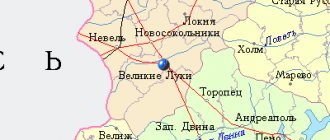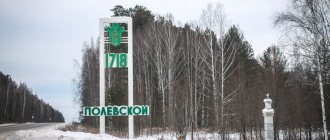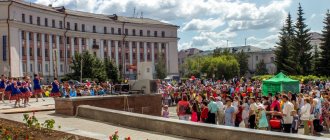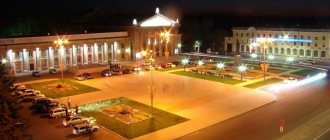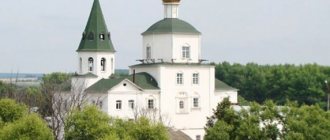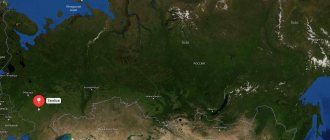Lyubertsy is the outskirts of the capital, sharing a common border with Moscow. If you look at the map of Lyubertsy from a satellite, you will notice that the city is located almost within walking distance from the Tagansko-Krasnopresnenskaya line of the Moscow metro. It is only about 20 km away from the Kazansky railway station.
On the site of the modern city there were previously rural lands; in the 17th century. the settlements were presented to Peter III. And only at the end of the 19th century, when a railway was laid through the settlement, which can be seen on the map of Lyubertsy with diagrams, the settlement began to acquire an industrial orientation. Small villages were united by the Ukhtomsky plant, workers began to arrive, and the settlement gradually grew.
Nowadays, the city is a railway junction on the Ryazan direction with developed industry and a population of more than 180 thousand. Lyubertsy is characterized by very dense buildings; the territory of the city, accommodating such a large number of residents, is only 12 km2.
You can view the location of the city, its neighborhoods and main objects on the map of Lyubertsy by district. The city is completely urbanized and has no ponds or forests. The only green area is the Park of Culture.
Map of Lyubertsy with streets
The city is connected to Moscow by railroad and highways. The railway station and bus station, as the map of Lyubertsy with streets shows, are located in the area of Volkovskaya Street at its intersection with Smirnovskaya.
The main transport artery is Oktyabrsky Prospekt, which is also part of the regional highway R-105. The outskirts of Lyubertsy are touched by the M-5 Ural federal highway. These are busy, wide highways along which city transport, transit trucks and cars travel. If you zoom in on the map of Lyubertsy with streets and houses, then in the microdistrict called “Town B” you can see where the metro station exits are located.
Main streets of the city:
- Volkovskaya;
- Initiative;
- Komsomolskaya;
- Smirnovskaya;
- Kirov;
- October prospect;
- Victory Avenue.
Both the central and secondary highways of Lyubertsy have very dense buildings. High-rise buildings are lined up along the streets close to each other, which can be seen on a map of Lyubertsy with houses. The first floors of most residential buildings are occupied by offices and shops.
Map of Lyubertsy with houses
At first glance, the city does not have a clear division into districts, but this is far from true. Local residents are well versed both in the geographical location of residential buildings and in their prestige for living. Thus, the village of Kalinina is considered the most unsightly. In the past, the factory area still looks gloomy today; there are many wooden houses awaiting demolition.
The city center, bounded by Oktyabrsky Prospekt and Kirova Street, is built up with high-rise residential complexes, made in an original design with bars, salons and restaurants. A map of Lyubertsy with house numbers will help you find and view the location of residential central blocks. The only disadvantage of this modern microdistrict is the lack of parking and the almost complete absence of playgrounds.
In the city center there are:
- MARRIAGE REGISTRY;
- Hospital town;
- Schools;
- Lyubertsy Technical School;
- Museum of Local Lore;
- Restaurants.
Residents of the city rightfully consider the most spacious and comfortable area to be the area where a military garrison was previously located. You can view it using a detailed map of Lyubertsy in the area of Shosseynaya Street near block 115.
There are many educational institutions in the city:
- 8 schools;
- 2 gymnasiums;
- Choreographic school;
- 2 sports schools;
- 4 technical schools;
- 12 universities.
Yandex maps of Lyubertsy help you find any institutions and residential buildings, which also display parks, cultural institutions, administration buildings, sports complexes and stadiums. The map is an indispensable assistant when moving around the Moscow region.
History of the city of Lyubertsy
The age of settlements is usually calculated according to the first written mention.
Lyubertsy was first mentioned in scribe books for 1623-1624. ...21 kilometers from the capital lies the city of Lyubertsy, once a village with nine peasant households...
One of the first names of this village - Nazarovo - did not catch on among the people. Another name - Liberitsy - seemed to the people a strange name, not Russian. Since then, attempts have begun to find a different, more acceptable name for the village. In 1632, after the construction of the Church of the Transfiguration of the Lord, the village became the village of Liberitsa.
There were originally two owners. Clerk Ivan Gryazev has six peasant households and clerk Fyodor Poroshin has three. And before them, the village belonged to the Gorstkins, and even earlier it was on the estate of Mikhail the Old and Bogdan Ozarn. Fyodor Poroshin does not fit into the further history of our city: he sold his share to Kuzma Urusov, and he, in 1627, to Ivan Gryazev, who became the sole ruler of a small village.
Gryazev was a Duma clerk. And the Duma clerks occupied not the last place in the Russian hierarchical ladder, second only to the boyars, okolnichy and Duma nobles. By origin, the clerk was unlikely to be of noble birth. The last name he got from an unflattering nickname eloquently testifies to this. Its bearer worked his way up into the public eye for a long time, paving the way to the highest echelons of power. In 1615, he was still only a clerk in the Rank Order, one of the central government institutions. But he is already appreciated. He is traveling with an embassy to the “Aglinsky land” - England. The next year he is sent to the Nogai, who fell behind Moscow during the Time of Troubles. Luck was with him. He brought the Nogai Murzas and all the ulus people under the royal hand into direct servitude, took hostages from near Bukhara and rescued 15 thousand Russians from Nogai captivity. For this alone, for the liberation of 15 thousand Russians from bitter captivity, one can pronounce his name with respect. Gryazev was close to the throne. The documents note his participation in royal celebrations: on the day of the Nativity of Christ, clerk Ivan Gryazev was at the sovereign’s table... On the day of the angel of Queen Evdokia Lukyanovna, he was at the table... He is still sent to other powers with an embassy. He was also required to receive foreign guests. On December 15, 1633, the sovereign had a Turkic (Turkish) ambassador, and the ambassadorial Duma clerk Ivan Gryazev spoke to him. And on the benches sat the boyars, okolnichy and solicitors in gold. Yes, the sovereign had bells (bodyguards) in a white dress. Gryazev gradually expanded his holdings, buying up neighboring villages and wastelands. Shortly before his death, he took another step towards the rise of Lyubertsy: he built a church, turning the village into a village. “A newly arrived church in the Moscow district, in the patrimony of clerk Ivan Gryazev, in the name of the Transfiguration of the Lord, and in the borders of John the Baptist, tribute was due 5 altyn 2 money, and of this year 140 (1632), February on the 24th day, according to the petition of clerk Ivan Gryazev, The Sovereign gave him a letter of non-conviction, and he was ordered to pay double the tribute from that church in Moscow. And on the 28th day of February, Ivan Gryazev paid that money for the current year 140.” Altyn is an old Russian coin in denomination of 3 kopecks, denga - half a kopeck. In Rus', before Peter 1, chronology was carried out “from the creation of the world,” and the world, as they say, was created 5508 years before the birth of Christ. The church was built in 7140. From this figure we subtract 5508 and get 1632, the date of construction of the temple. The church, of course, with reconstructions, served the residents of Lyubertsy for three long centuries and was destroyed in the mid-30s of our century. The bells were taken to the basements of the plant named after. Ukhtomsky and during the Great Patriotic War, apparently, they were melted down. The church fence was moved to the school building No. 1, and then it disappeared without a trace. It is unknown how old Gryazev was. Died May 14, 1634. He was buried in the fence of the Simonov Monastery in Moscow. Mere mortals were not buried there. During Soviet times, the monastery was blown up. Then Lyubertsy was owned by Ivan Gryazev’s brother Mina and his sister Praskovya. She was married to Miloslavsky, and Lyubertsy went to them. They continued the accumulation policy of the Gryazevs. In 1674, the Miloslavsky estate was bought by the Order of Secret Affairs. Lyubertsy was included in the group of villages, the economy of which was handled by the “quiet” Tsar Alexei Mikhailovich himself. The center became the village of Sokolovo on the Moscow River. After his death, the Order was disbanded and the villages were given away. Lyubertsy in 1776 was taken over by I.M. Miloslavsky, the beloved nephew of the first wife of Tsar Alexei Mikhailovich, and the Prozorovskys. In the village there were 10 peasant households with 31 male souls (women and young children were not taken into account). There was a patrimonial court and a boyar court.
They tried to change the name of the village in the middle of the seventeenth century, when, after the death of Tsar Alexei Mikhailovich, detailed inventories of the villages were compiled. Opposite the words “in the village of Liberitsy” in the inventory you can find the note “Veleli - Veritsakh”. But even though it was ordered to call the village “Veritsy,” the amendment was still forgotten. On February 15, 1705, according to Prozovsky’s will, Lyubertsy was denied to the favorite of Peter I, Alexander Danilovich Menshikov, who renamed the village of Lyubertsy to the village of Novo-Preobrazhenskoye. Menshikov was the emperor's right hand and always emphasized this closeness. With his characteristic determination, he crosses out the previous name of the village and gives it a new one - Novopreobrazhenskoe. It is not known for certain what made it change its name to Preobrazhenskoye - historical reasons - the name of the ancient rural church of the Transfiguration of the Lord or the desire to once again associate its name with the village of Preobrazhenskoye. The “old” Preobrazhenskoe village was a village that had long since become part of Moscow. It became famous for the fact that in it, while still a child, the future Tsar - Peter - more than once arranged amusing games with Menshikov. Liberitsy becomes the village of Novopreobrazhenskoye. Menshikov did everything to make the New Village eclipse the Old: he built a palace in Novopreobrazhenskoye, blocked a pond with a stone dam, and laid out a vast park. After Menshikov’s exile to Berezovo, the village became part of the treasury. Novopreobrazhenskoye has been known for more than a year or two. It passed through the entire eighteenth century. And in the nineteenth century, Novopreobrazhenskoye was mentioned on the topographic map of the Moscow province (compiled in 1866). For at least two hundred years, the name given by Menshikov remained dominant, although the people always retained its “underground” name - Liberitsy - Lyubertsy. This continued until the beginning of the twentieth century.
After the death of Peter I, Menshchikov fell into disgrace and Lyubertsy was given over to the Grand Palace. On April 16, 1753, Empress Elizabeth gave her nephew Grand Duke Peter Fedorovich the village of Novo-Preobrazhenskoye (Lyubertsy) and the village of Ostrov with its villages and villages. The Grand Duke and his wife (the future Empress Catherine II) came to Lyubertsy. The Grand Duke planned to build a luxurious palace in Lyubertsy. Where can I get materials? Four miles from the village, in the wilderness of the forest, a brick factory was founded - where the Lyubertsy silicate plant is today. History, as we see, repeats itself. But the palace was not completed. In December 1761, Elizaveta Petrovna died. Peter III was proclaimed emperor. He did not rule for long. In June 1762, the guards enthroned his wife under the name of Catherine II. Peter III was soon killed. Catherine, remembering Lyubertsy, although she wrote “Here we considered ourselves in paradise,” but never visited them again. Everything connected with her late husband was hateful to her.
The unfinished palace was dismantled and transported, brick by brick, to Moscow for the construction of the Orphanage. And the menagerie that was in Lyubertsy was sent to Izmailovo, except for one wild boar, which was shot and taken to the empress’s name day. She did not spare the Lyubertsy stud farm either. It was closed. Lyubertsy was empty. Their decline became sharply visible. And here's another new problem. The disease of the century—the plague—crept from the south. This “sticky disease” wiped out half the population of Lyubertsy and Pankiv. It was suppressed on December 2, 1771. The “plague riot” had not yet been forgotten, but new terrible events were already approaching. In the fall of 1773, “Emperor Peter” appeared in the Volga steppes. Lyubertsy residents, shivering, secretly passed on ridiculous rumors. They knew their master, Pyotr Fedorovich, well. Has he really risen from the dead? Little did they know that under the guise of Peter was hiding a fugitive Cossack, ataman Emelyan Pugachev. The impostor hatched a plan to march on Moscow along the Zaraysk-Kolomna-Lyubertsy line. But circumstances forced Pugachev to turn to the Don. At one time there was a version that the captured Pugachev was shown to the peasants in Lyubertsy, in what appeared to be a confrontation. Do our residents recognize the frail, shaven-faced Grand Duke in the burly bearded man? The version arose thanks to a short note in the magazine “Leaflet of the Moscow Local Historian” for 1925, where it was written in black and white: “Pugachev was transported in a wooden cage and, according to orders, his stops were in the field, but not in cities and villages. The people on his way through the Moscow province saw Pugachev only in the village. Domozhirov and s. Lyubertsy, where he spent the night. There is only a legend about its showing in Bronnitsy.” All wrong. The journalists were wrong. Pugachev's last overnight stay before entering Moscow took place in the village of Ivanovskoye, on the night of November 3-4, 1774. As for the Pugachevites, they actually reached our village. Thus, the Moscow Chief of Police Arkharov received an order: “For the search and capture of thieves and robbers who appeared near Lyubertsy, please send thirty Don Cossacks...”
Economy and industry Lyubertsy
More than 20 industrial enterprises have been built in a relatively small area of the city. Here is the famous helicopter factory, which produces the Black Shark and Alligator flying machines. At another large one, agricultural machinery is designed and assembled.
The city also produces:
- Construction materials and structures;
- Snow removal machines;
- Aluminum profiles for glazing of industrial buildings and residential buildings;
- Retail store equipment;
- Carpets and carpet products.
Most of the townspeople are employed in trade enterprises. There are a huge number of them in Lyubertsy. At every step there are fairs, shopping centers, markets, large and small shops. One of the large shopping centers that city residents prefer to visit is “Traffic Light”, which is located on Pbratymov Street. In addition to retail, wholesale trade is active in the city.
“Severe” Lyubertsy: Punks, WOOGS and Lyuberas
Stories
February 03, 2022 5 minutes Author: Ilya Buyanovsky 1261
We continue our walk around Lyubertsy, which we started in the last part. Smirnovskaya Street leads from the Lyubertsy-1 station to the long Oktyabrsky Prospekt, on which the city is literally strung. The intersection is known under the harsh nickname Lyubertsy Cross: it was the center of city life even in the most turbulent times.
print version all stories
The monument “Guys from our yard” (aka “Dusya-aggregat”), erected in 2015, reminds us of the recent past of these places, although the lead singer of the Lyube group, Nikolai Rastorguev, cast in bronze, is not from Lyubertsy, but from Lytkarino.
On the next Kurakinskaya street there is a monument to internationalist soldiers, opposite which, near the Oktyabr cinema, a small chapel of All Saints has stood since 1993. On her bas-reliefs there are not saints or angels, but simple Russian soldiers.
The next attribute of the center is the huge city hall building and the park in front of it. A couple of years ago, many macabre sculptures could be seen there, including a naked Harpy with chicken legs and all the anatomical details at the point of their convergence. And the surprise is not that all this was removed, but that they managed to put it on at all.
The city center is completed by the Lyubertsy Palace of Culture (1962), built on the site of the 18th-century Transfiguration Church, which was demolished in 1936. Of the thousands of typical Soviet recreation centers, it stands out for its history. Vladimir Vysotsky often performed here, and his last concert took place on July 3, 1980, a couple of weeks before his death. Leonid Filatov then performed as Vysotsky’s opening act and even read out to the people for the first time an excerpt from “Fedot the Sagittarius, the Daring Young Man.”
But somehow it happened, they didn’t want to let Vysotsky into the cultural center, without recognizing him to his face and deciding that he was a particularly arrogant spectator. Here Vysotsky had a guitar made: in 1972-76, Kiev resident Alexander Shulyakovsky, famous among musicians throughout the USSR, worked at the Palace of Culture. This is where Rastorguev started, then with the hits of the Beatles. And in 1986, this cultural center hosted the first USSR bodybuilding tournament, which was the “finest hour” of amateurs.
Behind the Palace of Culture, the avenue crosses with an overpass a small, inactive station called Boys on a side branch from the highway to Dzerzhinsky. These boys, as is commonly believed, were street children from the local commune.
And it was from the blocks behind the Boys station that the Lyuber movement began. By the end of its era, it degenerated into ordinary punks, but it all started differently. The first Lubers were by no means the type who pestered passers-by out of boredom over a beer at the entrance. Rather, they were a full-fledged subculture, starting with “athletes” involved in bodybuilding, weightlifting, swimming and boxing. Initially, without any aggression: some wanted to prepare themselves for the army, others wanted to look good so that the girls “in the area” would like them. Later, “hooligans” emerged from the “athletes,” but even they did not drink or smoke, avoided weapons in fights, relying only on their fists, did not beat one in a crowd, and generally tried not to attack those who did not play their games.
And yet the folk pastime “district to district, block to block” in Lyubertsy has reached rare proportions. The prowess of the Lyubertsy boys increasingly insistently demanded to express themselves, and on April 20, 1982, the Lyubertsy boys had a chance - a neo-fascist rally in the center of Moscow. So strong guys from the Moscow region came to this action and beat the villains with the full approval of the people and the police. After this, the “athletes” were legalized and even held a bodybuilding championship in the Lyubertsy Palace of Culture, while the “hooligans” found a calling for themselves - to “drive the hairy people,” that is, to beat up informals and other people whom they considered class aliens.
The five-story building in which the first Lyubertsy “rocking chair” was located.
The Lyubertsy even had their own anthem, written not without sarcasm, but which took root among them. Here I will quote his first verse, since what follows is extremism:
We were born and raised in Lyubertsy,
the Center of brute physical strength, But we believe: our dream will come true - Lyubertsy will become the center of Russia.
The starting point for the Lyuber movement can be considered a five-story building on Mira Street, 7a (corner of Khlebozavodskaya), in the huge basement of which the first, literally and figuratively, underground “rocking chair” settled in 1968.
Beating passers-by is illegal, especially since sometimes fights ended tragically. The winners were sent to trial, and returning from places not so remote, they formed the third subtype of Lubers - “those who served time.” They were united by thief in law Shishkan, aka Oleg Ramensky. By the early 1990s, the Lyubertsy criminal group had formed in the city, capable of fielding up to several hundred “fighters.” It was defeated already in the early 1990s, but organized gangs remained a feature of Lyubertsy for many years. For example, the Nikolai Kapuschu gang in 1995-97 was engaged in extortion from local businessmen, and the bandits did not even hesitate to kill children.
But now all this is in the past, and in Lyubertsy life outside Moscow goes on as usual. After the Boys come the Punks (emphasis on the last syllable), notable for several blocks of “Stalinist” architecture. The numbering of houses along Oktyabrsky Prospekt here is already approaching the fifth hundred. Behind houses No. 375 lies one of the most architecturally interesting quarters - the Yellow Town, built in 1947-49 by captured Germans.
Next is the Higher School - once a regional high school for the Moscow region was planned here. Now it’s just a block, the main building of which is occupied by a publishing plant, and on the sides there are colorful buildings from the mid-twentieth century.
In Panki there is also a quarter of the VUGI, that is, the All-Union Coal Institute, which has now become the Alexander Skochinsky Institute of Mining. Founded in 1927 in Kharkov for the mines of Donbass, in 1939 the institute moved to the Moscow region, expanding its profile to mining in general. Under the Soviets, he was involved in mining methodology, but under capitalism he found himself practically out of work. The huge and luxurious ensemble is now decaying on the outskirts. The main building in the “high Stalinist style” is the last one on Oktyabrsky Prospekt, which here splits into roads to Zhukovsky and Yegoryevsk. Along the latter, the VUGI ensemble stretches further. The old entrance to the city at the next overpass is marked by a pair of residential Stalinist towers with thin spiers.
Beyond the tracks lies Tomilino, a separate village, interesting for its industrial zone. First of all, helicopters are made here, but hidden in the depths of the Mil plant is also a small one, known primarily for the production of space suits. About his museum - in the next part.
Photo: Ilya Buyanovsky, Sergey Kalugin
Share:
